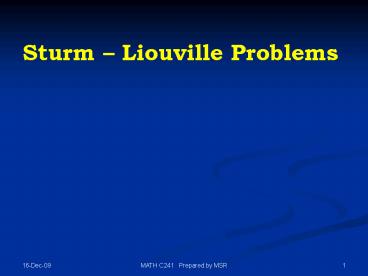Sturm Liouville Problems - PowerPoint PPT Presentation
1 / 38
Title:
Sturm Liouville Problems
Description:
Fact Any differential equation. can be made self-adjoint by multiplying by ... corresponding to each eigenvalue , there may exist one or two LI eigenfunctions. ... – PowerPoint PPT presentation
Number of Views:1523
Avg rating:3.0/5.0
Title: Sturm Liouville Problems
1
Sturm Liouville Problems
2
Second Order Exact Differential equations
The second order linear differential equation
is called exact if it can be written in the form
for some function S(x).
3
If the equation is exact, we get on integration
the first order linear equation
And this can be solved for y.
Expanding the second equation and comparing it
with the first, we find that a necessary and
sufficient condition for exactness is
4
Integrating factors
If
()
is not exact,
but becomes exact on multiplication by a function
? (of x), then ? is called an integrating factor
for the given equation.
Necessary condition for ? to be an I.F.
Suppose ? is an integrating factor for the given
equation. Hence
5
i.e.
Hence ? must be a solution of the equation
.. ()
() is called the adjoint of the equation ()
and is usually as difficult to solve as the
original equation ().
6
Theorem Adjoint of the adjoint is the original
equation.
Proof The adjoint equation of () is the
equation
which is the original equation
7
Find an integrating factor for the d.e.
and hence solve it.
Here
8
Hence the integrating factor satisfies the
equation
i.e.
By inspection we find ?
x.
Multiplying the given equation by the I.F. ? x,
9
we get the differential equation
which is same as
Integrating, we get
10
This is a first order linear equation in y.
Multiplying by the I.F.
And integrating we get the final solution
c1, c2 arbitrary constants
11
Self-adjoint Equations
A differential equation
is called self-adjoint if it is the same as its
adjoint. That is the above equation is same as
This happens if and only if
12
Thus a self-adjoint equation is an equation of
the form
which is same as
i.e.
13
Fact Any differential equation
can be made self-adjoint by multiplying by
Note that
on multiplying
by
becomes
Hence the result.
14
Problem 3 Page 329
Find the adjoint of the following equations (a)
Legendres Equation
This is same as
Hence the Legendres equation is self-adjoint.
15
(b) Bessels Equation
Its adjoint is the differential equation
The self-adjoint form of the Bessels equation is
16
(c) Chebyshevs Equation
Its adjoint is the differential equation
The self-adjoint form of the Chebyshevs equation
is
17
(d) Hermites Equation
Its adjoint is the differential equation
The self-adjoint form of the Hermites equation is
18
(e) Laguerres Equation
Its adjoint is the differential equation
The self-adjoint form of the Hermites equation is
19
Sturm-Liouville Problems
Consider a self-adjoint differential equation
We assume p(x), p? (x), q(x), r(x) are continuous
over the interval a, b.
We shall also assume that p(x) and q(x) are gt 0
for all x in the open interval (a, b).
20
We wish to find all ? such that non-trivial
solutions to the above d.e. exist that satisfy
either the homogeneous boundary conditions
where
i.e. at least one of the ci, and one of di ? 0
or the periodic boundary conditions
21
This eigenvalue problem is called a
Sturm-Liouville problem.
It can be shown that the above problem has a
sequence of eigenvalues
and that
We now show that the eigenfunctions corresponding
to distinct eigenvalues are
22
orthogonal over a, b with respect to the weight
function q(x).
Proof (of the orthogonality of eigenfunctions)
Let ?m, ?n be two distinct eigenvalues and let
ym(x), yn(x) be the corresponding eigenfunctions.
Thus
23
Multiplying the first equation by yn and the
second by ym and subtracting, we get
Integrating both sides with respect to x, from
x a to x b , we get
24
(No Transcript)
25
where
is the Wronskian of the eigenfunctions
ym(x), yn(x).
26
Case (i) Suppose the boundary conditions are
Hence
So
or
27
Case (ii) Suppose the boundary conditions are
Hence
So
or
28
Case (iii) Suppose the boundary conditions are
where
Hence we get
This homogeneous system has non-trivial solutions
for c1, c2. Hence the determinant
29
of the coefficients must be zero. That is
or
Similarly
Hence
30
Case (iv) Suppose the boundary conditions are
and we also assume that
Now
So
Hence
31
We also note that if the boundary conditions are
homogeneous, then corresponding to each
eigenvalue ?, there exists a unique eigenfunction
(all other eigenfunctions are nonzero multiples
of this).
If the boundary conditions are periodic, then
corresponding to each eigenvalue ?, there may
exist one or two LI eigenfunctions. All other
eigenfunctions will be nontrivial lc of these.
32
We also note that there cannot be more than two
LI eigenfunctions associated with a particular
eigenvalue ?.
Justification
For any particular ?, the second order
homogeneous linear differential equation
cannot have more than two LI solutions.
33
Consider the Sturm-Liouville problem
satisfying the homogeneous boundary conditions
34
We know that the eigenvalues are
n 1, 2,
And the corresponding eigenfunctions are
Noting that q(x) 1, we get
35
Consider the eigenvalue problem
We know the eigenvalues are
36
For n 1, 3, 5, the eigenfunction
correspondimg to the eigenvalue n2?2 is
For n 2, 4, 6, the eigenfunction
correspondimg to the eigenvalue n2?2 is
37
The selfadjoint form of the given equation is
Thus
38
And we get the orthogonality property of the
eigenfunctions, namely
End of Lecture































